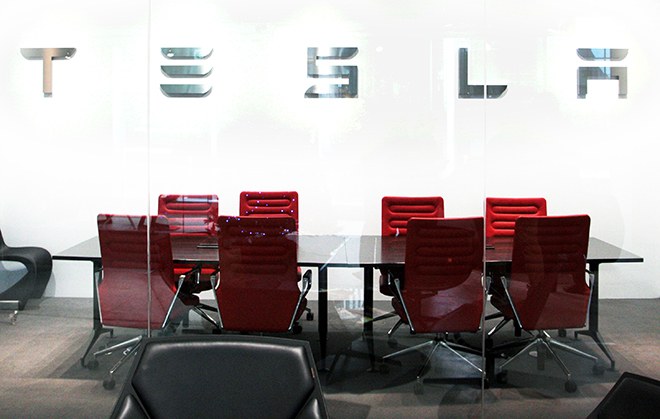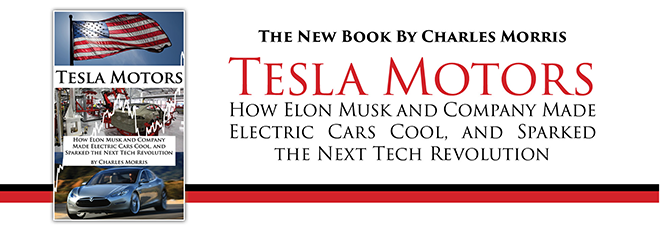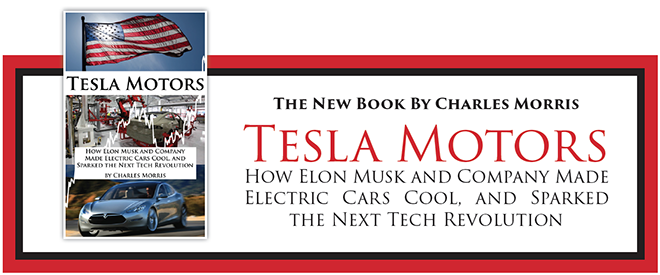This article is an excerpt from Tesla Motors: How Elon Musk and Company Made Electric Cars Cool, and Sparked the Next Tech Revolution by Charged Senior Editor Charles Morris. This 270-page book is a comprehensive history of Tesla, told by the entrepreneurs who made it happen, as well as an assessment of the company’s lasting influence on the automotive industry and beyond.
The five visionaries who founded Tesla – Martin Eberhard, Marc Tarpenning, Elon Musk, JB Straubel and Ian Wright – were certainly greenies, and the environmental value of EVs was one of their prime motivators. However, they were also rocket scientists and sports car connoisseurs, and they were well aware of another advantage that electric powertrains have over internal combustion engines. Dinosaur-burning engines deliver peak torque (rotational force), and thus maximum acceleration, only within a limited range of RPMs – that’s one of the reasons for a multispeed transmission. An electric motor delivers maximum torque from the moment you step on the pedal, and is highly efficient throughout the rev range.
The California company AC Propulsion had taken full advantage of this to build an EV called the tzero, which had a magic power: anyone who drove it instantly changed their opinion of electric cars. This was the rock that Musk and his Musketeers planned to build their company on. Shortly after Tesla was founded, Ian Wright negotiated a deal with AC Propulsion to license its motor and inverter technology.
The tzero’s performance was impressive, but as the Tesla team worked with it, they found that there was a lot of room for improvement. Chief Engineer JB Straubel and his team ended up redesigning almost every part.
Marc Tarpenning told me about the process of developing the custom-built tzero into a vehicle that could be mass-produced. “AC Propulsion had produced 60 drivetrains or something like that, all hand-crafted,” he said. “Each motor was matched with each inverter and they were all hand-tuned. This is not manufacturing, this is high-end hobbyist. It’s like when you buy an audio system from one of these places that makes a hundred stereos a year. We paid them a bunch of money to license [their motor] and we realized they couldn’t manufacture it, so we just designed our own motor which, in the end, was quite a bit different from what we started with.”
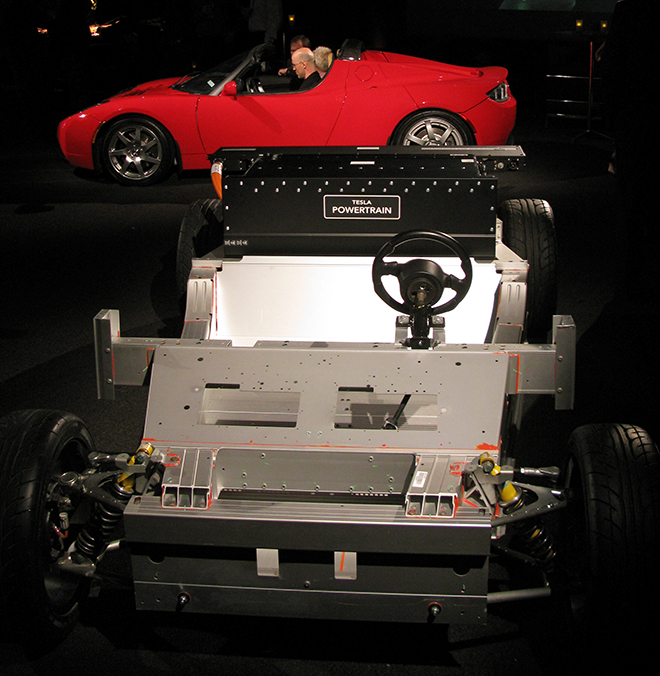 Image courtesy of Jurvetson/Flickr
Image courtesy of Jurvetson/Flickr
According to Tarpenning, the Tesla team moved on from AC Propulsion’s motor pretty early in the game. “We redesigned it a year before we were in production. We did need one for the mule [the first test vehicle]. But that was long before we were even into the engineering prototypes, let alone the validation prototypes, which then lead into production.”
The AC Propulsion guys, who didn’t get to ride the Tesla rocket to fame and fortune, remember things a little differently. Paul Carosa, AC Propulsion’s VP of engineering at the time (and now the company’s CTO), told me that Tesla “stopped paying royalties halfway through the Roadster production, claiming that they were no longer using our technology, which was not clear. If you look at the Roadster motor and the power modules, it’s essentially our technology there. I don’t think the relationship ended on a good note.”
Tom Gage, one of the designers of the tzero (and the subject of a feature article in Charged Issue 12 – February 2014) told me a similar story: “I think they paid a license for the first five hundred vehicles, and then there was a change in design which they claimed eliminated their reliance on our licensed technology. I wasn’t too pleased with the way they did things. They just sent an email saying, we’re going to stop paying a license fee now because we’ve changed the design. There was never any real discussion of what they had changed. It was hardball, but that’s the way they do things in the auto industry.”
The way that the patents and the contract were written, it would have been difficult to prove that Tesla did anything wrong, and AC Propulsion didn’t want to get into a legal battle. “After all was said and done, our patent wasn’t as clear as it should’ve been,” said Gage. “So, [a lawsuit] would’ve made the lawyers rich but probably nobody else.”

“To this day, there’s still a fair amount of our DNA in the Tesla design, which is not to say they haven’t made huge progress and improvements, especially relating to manufacturability and mass production and liability,” said Gage. “But, AC Propulsion was really a very significant jumping-off point for Tesla in all of the basic propulsion and battery system efforts that they pursued. They got a pretty good deal from AC Propulsion.”
Control issues
One of the critical components of an EV is the motor controller, which handles the complex interaction among the driver, the battery and the motor in order to deliver a smooth ride. JB Straubel envisioned a digital control system that would replace AC Propulsion’s analog controller. Straubel gave Andrew Baglino, one of the engineers he had hired, a project: he was to design a set of test equipment that would be used for endurance testing on the motors and batteries, something that would be quite necessary for the process of building a reliable production vehicle. It took months, but when it was done, as Straubel had intended, the lessons learned in developing the digital test equipment also allowed the team to build a dandy digital motor controller, which vastly improved the Roadster’s responsiveness and ride.
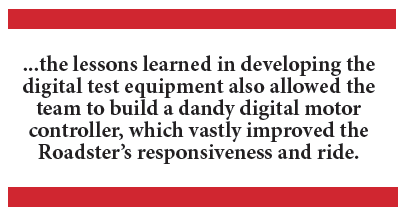
The motor and transmission also ended up getting the Straubel special. Just before the team was ready to put the Roadster into production, they realized that the car’s original two-speed transmission was wearing out much too quickly. Straubel and his team re-engineered the motor’s metal plates and wire coils, giving it more efficiency and more torque, which enabled them to get the desired performance from a simpler single-speed gearbox.
The batteries
When Tom Gage and his team built the second generation of the tzero, they were able to make a huge improvement by taking advantage of a new technology that was just becoming commercially available. In fact, this was the key technology that made the current generation of EVs possible – the lithium-ion battery.
The first tzero used 28 Optima Yellow Top lead-acid batteries, which weighed 1,000 pounds and were mounted in the vehicle’s sides. This meant that the doors didn’t open the way most car doors do. “They were actually only maybe about 8 inches tall and kind of opened upwards at a 45-degree angle and you had to step over the side,” Carosa told me. “You were actually stepping over the batteries. It was like a high sill on the side of the car and you had to step up a couple of feet over it.”
Around 1989, a new battery technology called Nickel-metal hydride (NiMH) became commercially available. NiMH cells offer much better energy density than lead-acid, so new applications became practical. NiMH cells enabled the second generation of GM’s doomed EV1 to greatly improve its range, and they made hybrid vehicles such as the Toyota Prius practical.
In 1991, the first lithium-ion batteries came on the market. Lithium-ion batteries offer even better energy density than NiMH, and they retain their charge pretty well when not in use. They have become ubiquitous in consumer electronics – in fact, the current generation of smart phones wouldn’t be possible without them – and they remain the state of the battery art.
EV pioneers like Gage and Eberhard immediately saw the potential of the new battery technology. By replacing the original tzero’s lead-acid batteries with lithium-ion cells, they were able to more than triple the car’s range. There was never any question for the Tesla team that lithium-ion batteries were the way to go for the Roadster’s battery pack (which Tesla refers to as the Energy Storage System, or ESS).
The idea of using the laptop-style (Panasonic 18650) lithium-ion cells was a “great minds think alike” moment. Neither the AC Propulsion guys nor the Eberhard/Tarpenning team claimed the inspiration – all told me that both teams were already working with the idea when they joined forces.
Marc Tarpenning oversaw the engineering of the Roadster’s battery system. “A battery system, almost like a disc drive, has lots of different parts,” he said. “It has mechanical components, and there’s a lot of mechanical engineering involved and safety as well, both mechanical and electrical. Then, there’s a whole bunch of computers, fourteen computers in a battery pack. So, my world is really about the computers, the software and the firmware.”
As Tarpenning recalls, the second-generation tzero was “sort of our proof of concept that this could work, that lithium-ion cells were the right way to go – these little 18650s.” He and Martin Eberhard had used 18650 lithium-ion cells in e-books when they worked together at a company called NuvoMedia. “You had to be careful with them because they were a lot more finicky to work with [than NiMH], but their energy density was so much better that it would be ridiculous not to spend a little bit of engineering time to work with them,” said Tarpenning, “and they kept getting better. Every time we looked around they were another 7% better or 7% cheaper. They were kind of in a slow Moore’s Law.”
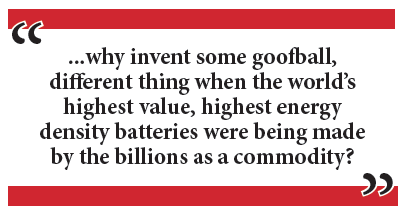
“This chicken and egg thing around the batteries is ridiculous – why invent some goofball, different thing when the world’s highest value, highest energy density batteries were being made by the billions as a commodity? It was so obviously the thing to do.”
Safety was very much on everyone’s mind. Like gasoline, uranium, or anything that stores a lot of energy, lithium-ion cells can be dangerous if mishandled. If they are damaged, overcharged, or overheated, they can burst into flames or even explode. In fact, as Straubel and his team of engineers discovered, in rare cases, an invisible flaw within a single cell can cause it to overheat without warning, and set off a chain reaction called thermal runaway. In 2006, Sony recalled millions of laptop batteries after it identified such a manufacturing defect.
The negative publicity that could result from any battery overheating incident, whatever the cause, was easy to imagine. The facts that tanks of gasoline are also highly flammable, and that thousands of gas-powered vehicles catch fire every year, would not prevent the press from making the most of any EV battery fire, as Tesla learned in 2013, when three Model S batteries caught fire in separate incidents after collisions, causing a PR nightmare for the company.
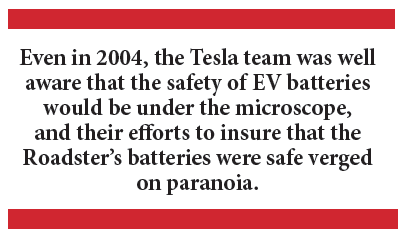
Even in 2004, the Tesla team was well aware that the safety of EV batteries would be under the microscope, and their efforts to insure that the Roadster’s batteries were safe verged on paranoia. Straubel and his crew put the battery packs through extensive testing, heating individual cells until they burst into flames. They designed the packs so that each cell is isolated enough from its neighbors that a single overheating cell won’t cause a chain reaction. They built in an array of sensors that monitor acceleration and deceleration as well as any tilting of the vehicle, in order to detect a crash. There are also sensors that detect smoke and overheating. In the case of any abnormal event, the power system shuts down.
Using a battery pack with 6,831 individual cells presented another challenge: all those cells must be connected together not only with power connections, but with data connections that allow the system to monitor the state of charge and temperature of each cell.
Another issue is cooling. Batteries need to be kept within an optimum temperature range, not just to prevent overheating but also to maximize battery life. Some EVs employ a liquid cooling system, while some (such as the Nissan LEAF) get by with air cooling. The team had a lot of heated discussions about which direction they should go, but finally decided on a liquid cooling system, with a network of tubes running through the pack.
As every laptop owner knows, lithium-ion batteries lose their capacity to store energy as they get older, and in 2004, no one was sure that they would last long enough to be truly practical for automotive applications. A smart phone might go through a few hundred charge/recharge cycles before being cast aside in favor of a shinier and newer toy, but a car buyer is going to expect the power source to last approximately the life of the car – 8 to 10 years, or some 5,000 to 8,000 cycles. In the event, this proved not to be a major problem. Tesla predicted in 2006 that the Roadster’s battery packs would have 70% of their capacity left after 50,000 miles. A July 2013 study from Plug In America, based on a survey of 126 Roadster owners, projected that at 100,000 miles, Roadster batteries would still have between 80% and 85% of original capacity. The few Roadsters in the study at or over the 100,000-mile mark in 2014 are meeting that projection.*
Elise + tzero + Special Sauce = Roadster
The Teslers adapted the tzero’s powertrain for their new vehicle, but not much else. As Ian Wright told me, the tzero never pretended to be a production car, but “you could see that yes, you could make something really nice with this technology, if it just didn’t have all the shortcomings that the prototype had.” They had no intention of using the kit car’s ovate fiberglass body, or its heavy steel frame. They meant to assemble a car that excelled in every detail, and for several of the puzzle pieces, they turned to a sports car maker that they all admired – Lotus.
Lotus was founded by engineers Colin Chapman and Colin Dare in 1952. Since 1966, its headquarters and main factory have been located at Hethel, a former RAF airbase in Norfolk, England, with the old runway serving as a test track. Lotus Engineering is a subsidiary that does contract work for other automakers, and many of the world’s most famous high-performance cars have taken advantage of its design services, although that fact is seldom advertised.
“Lotus Engineering is one of the premiere auto engineering companies in the world when it comes to suspension design, tuning, ride and handling development,” said Ian Wright. “I remember being very humbled one day when they offered us a chance to drive on their test track with one of their development drivers – those guys are unbelievably good. They tell stories where they send the development driver out on the track, and he does a few laps and then, without him being able to see what they do, they change one of the damper fittings on the left rear by one click, then they send him back out on the track, then ask him, ‘What did we change?’ and he tells them.”
 Image courtesy of Jyri Engestrom/Flickr
Image courtesy of Jyri Engestrom/Flickr
Some have written that the Roadster was “based on” the Lotus Elise, but this is a vast oversimplification. In fact, the two cars share around six percent of their components. The Roadster incorporates a lot of styling and other elements from Lotus, and some of the powertrain of the tzero, but Tesla made so many modifications and improvements to almost every part that it really is a new vehicle.
Eberhard and Tarpenning approached Lotus’s Roger Becker at the 2003 Los Angeles Auto Show, and talked him into partnering with their nascent company. Ian Wright was the one who finalized the deal, flying back and forth to England to work out the details. Eventually, the two firms cooperated on several different levels. Tesla licensed various technologies from Lotus, and also worked with Lotus Engineering for much of the design work on the Roadster. When it was time to begin production, Tesla contracted with Lotus to manufacture the cars in its legendary factory, with Tesla supplying most of the parts.

When Lotus chief engineer Richard Rackham designed the Elise chassis, he cleverly used extruded aluminum members that are glued, or bonded, together, rather than welded. This allows for an optimal tradeoff between strength and weight, very important for an EV, which needs to be as light as possible to maximize range. The Tesla team took full advantage of this technology, but redesigned the chassis in several ways.
They lowered the height of the door sills by two inches, making it easier for tall chaps like Musk and Eberhard to get in and out. They also rearranged the layout for a car that would be heavier than the Elise, and that would have a battery pack but no gas tank, muffler or tailpipe. They made the overall wheelbase about two inches longer to accommodate the battery, and made several other revisions and improvements.
In early 2005, Lotus provided a couple of glider versions of the Elise. A glider is a car with no engine or transmission, and Tesla would use these to test their electric powertrain. When the boys installed their electrified innards into the glider, they had themselves a mule, which is a working car that can be driven to test various components on the road (according to Marc Tarpenning, it’s called a mule because, like the equine animal, it doesn’t reproduce).
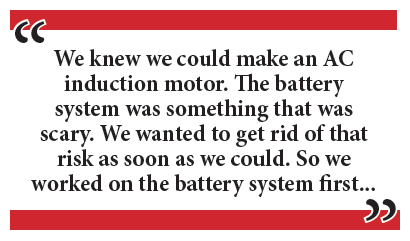
“To get a car onto the road from scratch, it costs hundreds and hundreds of millions of dollars,” Tarpenning told me. “Our whole business plan was based on the fact that we weren’t going to do that – we were going to develop a drivetrain and then we were going to take a design that had already passed the crash and safety tests both in Europe and America, that we knew could qualify as being a real car. We knew we could make an AC induction motor. The battery system was something that was scary. We wanted to get rid of that risk as soon as we could. So we worked on the battery system first and we made a Lotus Elise into a mule, using our first-generation battery pack, an AC Propulsion inverter and an AC Propulsion motor. We drove that around, and that allowed us to get more people interested and to raise more money. It validated that the battery system was going to be okay, we were going to have a couple hundred miles of range and it was going to be really fun to drive. It was a great test platform for all kinds of stuff.”
Lotus provided the airbag system and ABS brake system, components that would have been very difficult for Tesla to develop on its own. This is why the Roadster’s steering wheel and dashboard look pretty much like the Elise’s. Most of the rest of the interior is all Tesla. The Californians also used the Elise’s windshield and other windows (called the greenhouse or glasshouse in the trade). To roll their own would have meant dealing with a host of related issues including visibility requirements, rollover protection, waterproofing, windshield wipers and more. However, they upgraded to a UV-resistant type of glass that keeps the car’s interior cooler.
Tesla added several high-tech touches, including a color LCD display, a Blaupunkt stereo with a jack for an iPod, and the now-famous Tesla doors with their flush-mounted handles. Those door handles – which are operated electronically, and not only look cool but make the car almost impossible to break into – were one of several features that were the subjects of intense debate during development.
Elon Musk was determined to build “not just the best electric cars, but the best cars.” This was a grand strategy, and a risky one. Every added goodie meant more cost and more time. Among the controversial changes was the lowering of the door sill, which made getting in and out of the car easier, but sacrificed much of the cost savings from using Lotus’s existing chassis. “I was very insistent on things during the design phase, and it is true those things cost money,” Musk told CNN in a 2008 interview, “but you can’t sell a $100,000 car that looks like crap.”
One major decision concerned the material that would be used for the body. Again, the boys ended up deciding to go all the way, and use the best material available – carbon fiber composite (aka carbon fiber reinforced plastic or CFRP). As strong as steel, as light as aluminum, and much more flexible to work with than either, this space-age stuff is emerging as the ultimate material for automobile exteriors. It still isn’t cheap, and in 2004, deciding to use it was a bold move. Musk was particularly adamant that the Roadster should use carbon fiber, and he eventually convinced the others.
Once this decision was made, of course, the team was no longer building a modified Elise, but a completely new car, and they had the freedom to design the body however they wanted.
The styling
People who aren’t “into cars” might be amazed to learn how much effort automakers devote to a model’s physical appearance. The Founding Fathers, however, were very much car guys, and they wisely spent a lot of time and money on getting the Roadster’s styling just right. Make no mistake, people perceived the Roadster as a different animal from previous EVs not only because of its performance, but because of its looks.
Once the team had figured out what the overall dimensions of the Roadster would be, they engaged several renowned sports car designers to submit proposals for its styling. Martin Eberhard had a clear vision in his mind of how he wanted the car to look, and he tried to explain his ideas to the stylists. Apparently, however, they were all thinking in terms of a stereotypical “electric car,” and the first designs that came back looked like cheesy space vehicles, complete with solar panels and other science-fictionesque gizmos – precisely the opposite of what Eberhard and company wanted.
Eberhard’s next call was to his friend Bill Moggridge, a London-born “designer’s designer” who designed the first laptop computer, and co-founded the design studio IDEO. Moggridge (1943-2012) was a pioneer of the human-centered school of design, and is said to have coined the term “interaction design” to describe an approach that focuses on the needs of the people who will be using a product.
Moggridge created a scheme that described the appearance of a car in terms of five separate characteristics, each of which was presented as a continuum with an example car at each end – for example, from masculine to feminine, from retro to ultramodern, etc. Eberhard then chose a point along each axis that represented where he imagined the look of the Roadster. They showed this to the designers working on the project, and the next round of proposals was much more in line with what Eberhard and his team had in mind.
Dozens of sketches from the designers were hung on the walls of a room at Eberhard’s house, and over 50 people were invited to vote for their favorites. Barney Hatt, a member of the Lotus Design Studio, emerged as the clear winner. Over the next few months, Eberhard and the others worked closely with Hatt, tweaking every detail of the new car’s styling. Elon Musk was also deeply involved in the details of the design – among other things, he insisted on developing custom headlights, which was an expensive process, but had a lot to do with the impressive appearance of the Roadster’s front end.
After several trips to England and a succession of models at various scales, the pioneers’ vision was realized. In May 2005, they completed a full-scale model, formed from clay and surfaced with a high-tech carbon fiber coating from 3M called DI-NOC.
This was a significant visual milestone, but much remained to be done before the Roadster hit the road. The development of any new car involves extensive testing of all the major components and systems, which requires building all sorts of models, prototypes and pre-production vehicles. For Tesla, which obviously didn’t have the vast complex of labs and shops that a major automaker has, all this required some ingenious improvisation and more than a little help from their friends at Lotus.
While one team used the mule to perfect the powertrain, another group used the clay model to work on the aerodynamic tuning – important for any car, but critical for an electric model, as better aerodynamics translates to better range.
By January 2006, Tesla had built a second drivable mule, and was assembling the first engineering prototype. Between then and early 2007, Tesla built ten of these (EP1 through EP10), which were continually taken apart and reassembled to test various components. Once all the pieces of the puzzle were more or less perfected, the company built about 26 validation prototypes (VP1 through VP26), beginning in March 2007. These were almost-final versions of the automobile, and were used for endurance and crash testing.
Tesla made automotive history on July 19, 2006, when it officially unveiled the first electric car of the modern era for an audience of 350 invited guests in a hangar at Santa Monica Airport. The cars on display were actually the first two engineering prototypes, EP1 and EP2. The new stars also posed for the cameras at the San Francisco International Auto Show in November, where Governor Arnold Schwarzenegger highlighted the Roadster in a speech.

Of course, Tesla didn’t have the resources to mount the kind of massive media blitz that a major automaker devotes to a new model, but as Elon Musk and his crew sensed intuitively, it wouldn’t need to do so. From the very beginning, the story of the internet superstar and his plucky little car that was going to save the planet at 125 mph was catnip to the press.
The first hundred cars went to an elite group that included famous actors and other opinion-makers. Several famous entrepreneurs made major investments in the company, and their names brought a lot of publicity. Tesla began to be a hot topic in the silicon-centric circles of the digital entrepreneurial 21st-century Masters of the Universe. From this point on, Tesla remained at the center of the green (in both the environmental and monetary senses) spotlight and, as Musk might say, the marketing took care of itself.
Charles Morris goes on to tell the story of how the Roadster took the automotive press by storm (a little too stormy in the case of the British TV show Top Gear, with which Tesla got into a lengthy round of recriminations and lawsuits). But a rocky road lay ahead. A tide of red ink threatened to swamp the company before it could get the Roadster to market, and personality clashes in the boardroom caused the original management team to break apart. For more information on Charles’s new book, see www.teslamotorsbook.com.
*A previous version of this article stated that the July 2013 study from Plug In America surveyed 126 Roadster owners who found that, after 100,000 miles, most of the batteries retained 80-85% of their original capacity. However, the survey reveled a trend line that led to that prediction, and there were no Roadsters with over 100,000 miles in the survey when that was written.
Top image courtesy of Norio NAKAYAMA/Flickr




